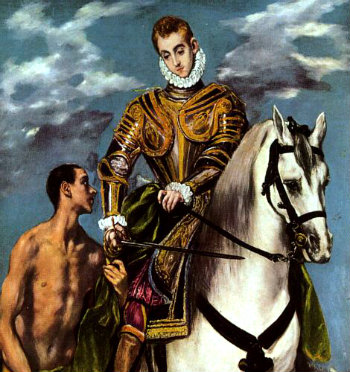100 Greatest Painters Artists Alphabetically Artists by Country Artists by Century Artists by Movement
Mannerism Art Style

Mannerism examples - Saint Martin and the Beggar, c. 1597, by the Greek mannerist painter El Greco
Mannerism Characteristics
The name mannerism comes from the Italian maniera, which translates to 'style'.
Mannerism is an artistic style that surfaced after the Sack of Rome on May 6 1527, when Charles V, Holy Roman Emperor descended upon Rome raping, plundering and massacring. Many great artworks were destroyed or carted off. This senseless slaughter unhinged Renaissance confidence, humanism and way of thinking to the core. The style originated in Rome and later widened to all of Europe. Mannerists paintings are characterized by elongated limbs, thin aquiline noses, overly stylized figures, undersized heads, electrifying, vibrant colors and elaborately mannered, theatrical compositions. According to Renaissance scholar John C. Van Dyke "They produced large, crowded compositions, with a hasty facility of the brush and striking effects of light. Seeking the grand they overshot the temperate. Their elegance was affected, their sentiment forced, their brilliancy superficial glitter. When they thought to be ideal they lost themselves in incomprehensible allegories; when they thought to be real they grew prosaic in detail. These men are known in art history as the Mannerists, and the men whose works they imitated were chiefly Raphael, Michael Angelo, and Correggio. "
The Mannerists in Italy worked on generous commission for a restricted audience of Vatican powerbrokers and royalty. The subjects they were allowed to portray was controlled and restricted to biblical themes, portraiture and occasionally mythology. El Greco said to hell with the money went off to Spain to pursue his own amazing vision
Characteristics of the Mannerist Style
Originating in Italy, the term mannerism comes from the Italian 'maniera', which translates to 'style'. Mannerism is an artistic style that was born in the early 1500s. The style originated in Italy and later widened to all of Europe. Mannerists paintings are characterized by elongated limbs, thin aquiline noses, long tapering fingers, undersized heads, garish colors and elaborately mannered, contorted postures. The Mannerists in Italy worked on commission for a restricted audience of Vatican powerbrokers and royalty. The subjects they were allowed to portray was controlled and restricted to Biblical themes, portraits and occasionally mythology. El Greco spurned the sumptuous commissions in favor of artistic freedom went off to Spain and to pursue his own magnificent vision.
Masters of The Mannerist Style
Important Words, People, Phrases, Characteristics related to the Italian Renaissance Art Movement - rebirth, rediscovery of the classical world, City-state, Humanism, Humanist, Francesco Petrarch, Reform, The Prince, Theocracy, The Inquisition, Human Reasoning, Medici Academy, publication of Della Pittura, a book about the laws of mathematical perspective for artists, sfumato, chiaroscuro, linear perspective, Heliocentric Theory, Petrarch, Baldassare Castiglione, The Book of the Courtier, liberal arts, civic humanism, Verrocchio, secularism, Leonardo Bruni, Lorenzo Valla, Neo-Platonism, nominalism, Giotto, Masaccio, Botticelli, Quattrocento, vanishing point, Savonarola, oligarchy spiritually significant, illuminated manuscript, idealized biblical themes, scriptorium, emotion, illuminator, iconoclast, Michelangelo and Leonardo Da Vinci, Age of Discovery, axonometric drawing, curiosity about the natural world, mythology, realistic use of colours and light, Bonfire of the Vanities, Old Testament stories, ethereal and foggy backgrounds, Gospel parables, The Blackdeath, romanticized landscapes, Christian symbolism. Paradise
☼☼☼☼☼
If you feel you have worthwhile information you would like to contribute we would love to hear from you. We collect essential biographical information and artist quotes from folks all over the globe and appreciate your participation. When submitting please, if possible, site the source and provide English translation. Email to historyofpainter@gmail.com
© HistoryofPainters.com 2017
If you like this page and wish to share it, you are welcome to link to it, with our thanks.
Popular Questions About Renaissance Art History
What is the difference between Italian Renaissance art and Northern Renaissance art?
How did the Black Death impact European art history?
How did the Inquisition impact European art history?
What was the influence of the Medici Academy on Renaissance painters?
What was the Bonfire of the Vanities?
Who were the greatest painters of the Renaissance?